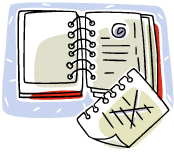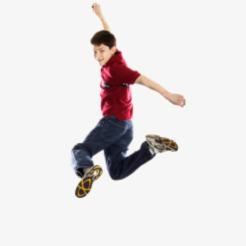Children with Attention Deficit Hyperactivity Disorder (ADHD)
Children with ADHD struggle with attention difficulties. Many can initially pay attention to a topic, but most cannot maintain that attention for more than a few minutes. Many people think that ADHD is mainly a school or academic difficulty. It is actually much more than this. ADHD can have an impact on every aspect of the child’s life. They may find it difficult to follow up with conversations with others and may find it difficult to pay attention to a speech.
The DSM-IV-TR (2000) (see full Glossary) classifies the symptoms of ADHD into three broad categories: inattention, hyperactivity and impulsivity. Inattention must be present, if a child is to be diagnosed with ADHD. When it comes to hyperactivity and impulsivity, only one should be present, in order for a diagnosis of ADHD to take place (Fig. 1):
Figure 1. ADHD
- Inattention, which includes (but is notlimited to) the following symptoms:
- Difficulty paying attention for more than a few minutes;
- Difficulty following directions and instructions;
- Often forgetting to do something;
- Often losing things.
- Hyperactivity, which includes (but is not limited to) the following symptoms:
- Having difficulty sitting still for more than a few minutes;
- Fidgeting and squirming in one’s seat;
- Running or moving around excessively.
- Impulsivity, which includes the following symptoms:
- Blurting out answers before hearing the question;
- Having difficulty waiting in line or for his or her turn;
- Constantly interrupting others.
The child must exhibit ADHD symptoms for at least six months, before a diagnosis can be made. Some of the symptoms must be present in more than one setting (APA, 2000).
Although many children with ADHD display some of the symptoms of ADHD before seven years of age, most do not get diagnosed with ADHD before they are 8 or 9 years old.
ADHD can have a tremendous impact on most developmental areas, as can be seen below:
- Cognitive development: some children with ADHD reach certain cognitive milestones later than other children, because it is so difficult for them to pay attention and learn. Although most have typical intelligence, they tend to score on the lower end of the typical intelligence spectrum on IQ tests (see full Glossary). Some may appear not to know a certain color or concept, only because they quickly give answers to questions, before they actually hear the question. In other words, they sometimes give answers to questions they do not even know;
- Academic skills: many children with ADHD perform less well than their peers in almost all academic areas. Many learn how to read, write and do math later and at a much slower rate than their peers because of attention, hyperactivity and impulsivity difficulties;
- Social/emotional skills: some children with ADHD struggle with both social and emotional development, again because of attention difficulties:
- Social skills: many children with ADHD struggle with social skills, because it can be difficult for them to listen to others, wait for their turn and sit still. Some do not have a lot of friends;
- Emotional skills: some children with ADHD have negative self-esteem (how a child feels about him/herself) and low self-confidence. They may not have a lot of friends and are sometimes embarrassed when they miss out on something because they did not pay proper attention to it;
- Mental health issues: some children with ADHD experience a lot of anxiety because of their attention difficulties. In fact, there appears to be a higher rate of depression and anxiety-based disorders in children and teens who have ADHD.
Some children with ADHD also have a learning disability. Many are also gifted.
ADHD is not just an academic disorder. It has an impact on every aspect of a child’s life. Many children with ADHD have Individualized Education Plans (IEPs) (see full Glossary) in school to adapt their work in terms of shorter activities or extensions when needed. The school’s special educator can usually help the child with ADHD function well in a regular classroom. The special educator usually works very closely with the regular education teacher in order to make the classroom less distracting to the child with ADHD (perhaps by hanging fewer items on the walls and giving the child special seating). The special educator can also help the child with ADHD manage and improve his or her attention, hyperactivity and impulsivity skills by teaching him or her specific strategies that they can use in the classroom. Some examples of such strategies include:
- Giving them graphic organizers (Fig. 2) and outlines of what needs to be done in class;
Figure 2. Graphic organizer
- Allowing them to take frequent breaks;
- Breaking down what they have to do into smaller steps or chunks;
- Giving them an hour glass (Fig. 3), which can show them how long they have to wait, before they can take a break;
Figure 3. Hour glass
- Giving them “stress” toys, such as objects that they can hold in their hands and squeeze. This (Fig. 4) appears to release some of the energy that these children have inside them. In high school, some students with ADHD engage in knitting during class. Again, this takes away that enormous energy that some of these students have, therefore allowing them to pay attention to what is happening in class;
- Giving them checklists of what they need to take home or to school every day.
Figure 4. Stress toy
Children with ADHD who also struggle with a mental illness or disorder may need regular sessions with a licensed clinical psychologist as well as the school counselor.
Some children with ADHD are prescribed medication to help them regulate their attention and impulsivity. The issue of placing children with ADHD on medication is somewhat controversial. Ultimately only parents can decide whether or not they would like to place their child on such medication. Parents need to know what the side and long-term effects of these medications are before they make their decision. Also, medication alone is never enough. Children with ADHD, even if placed on medication, will still need to learn how to pay attention, sit still and calm down.
Most children who have ADHD continue to struggle with some of the symptoms of ADHD well into their adulthood. Although they may continue to need help, most end up leading very happy and fulfilling lives (Fig. 5).





0 comments
Kick things off by filling out the form below.
Leave a Comment